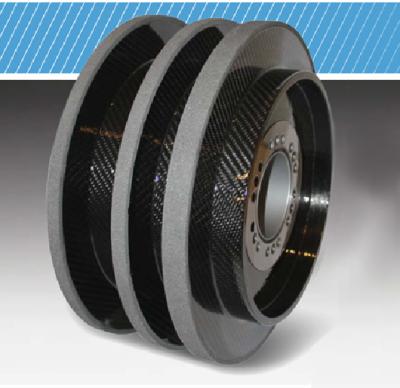
Saint-Gobain Abrasives has introduced CarbonForce, a new lightweight line of vitrified CBN wheels for OD grinding. With proprietary high-strength carbon fiber cores, CarbonForce wheels are 75 percent lighter than heavier steel-hubbed wheels and provide the safety and performance-enhancing benefits of a precision superabrasive wheel, according to the company.
With their lightweight carbon fiber core, CarbonForce wheels reduce labor costs and strain on the operator and often eliminate the need for a crane because they meet most safe lifting weight limits. The wheels exhibit high strength vs. centrifugal force and have been qualified to run at MOS of 31,496 fpm (160 m/s) for wheels with an OD greater than 7.9” (200mm). In addition, the low thermal expansion of the carbon fiber increases safety and performance.
The combination of a robust, thermally stable, lighter weight core with vibration dampening technologies and an advanced vitrified CBN bond system means CarbonForce wheels require less operator intervention to control part quality. This dynamic combination reduces dressing frequency, while increasing wheel life.
The new Norton wheels provide dramatically reduced cycle times by allowing the operator to mount four CarbonForce wheels vs. one steel rim wheel onto a four-phase cam shaft for simultaneous grinding of all four lobes in one operation. Cycle time, changeovers, dressing frequency and labor costs can all be reduced by up to 75 percent by changing out all four wheels.
The lightweight design of CarbonForce wheels extends bearing, spindle and overall machine life and reduces power draw and energy consumption for acceleration and deceleration in linear and rotary movement. All wheels are also equipped with a steel bushing to ensure long life of the wheel bore.
All Norton CarbonForce wheels are made-to-order with a maximum diameter of 1,000mm and a maximum width of 650mm. Large, complex wheel set designs are available with CarbonForce’s compact, lightweight core.
Contact Details
Related Glossary Terms
- bushing
bushing
Cylindrical sleeve, typically made from high-grade tool steel, inserted into a jig fixture to guide cutting tools. There are three main types: renewable, used in liners that in turn are installed in the jig; press-fit, installed directly in the jig for short production runs; and liner (or master), installed permanently in a jig to receive renewable bushing.
- computer-aided manufacturing ( CAM)
computer-aided manufacturing ( CAM)
Use of computers to control machining and manufacturing processes.
- cubic boron nitride ( CBN)
cubic boron nitride ( CBN)
Crystal manufactured from boron nitride under high pressure and temperature. Used to cut hard-to-machine ferrous and nickel-base materials up to 70 HRC. Second hardest material after diamond. See superabrasive tools.
- dressing
dressing
Removal of undesirable materials from “loaded” grinding wheels using a single- or multi-point diamond or other tool. The process also exposes unused, sharp abrasive points. See loading; truing.
- grinding
grinding
Machining operation in which material is removed from the workpiece by a powered abrasive wheel, stone, belt, paste, sheet, compound, slurry, etc. Takes various forms: surface grinding (creates flat and/or squared surfaces); cylindrical grinding (for external cylindrical and tapered shapes, fillets, undercuts, etc.); centerless grinding; chamfering; thread and form grinding; tool and cutter grinding; offhand grinding; lapping and polishing (grinding with extremely fine grits to create ultrasmooth surfaces); honing; and disc grinding.
- outer diameter ( OD)
outer diameter ( OD)
Dimension that defines the exterior diameter of a cylindrical or round part. See ID, inner diameter.
- reaction injection molding ( RIM)
reaction injection molding ( RIM)
Molding process that allows the rapid molding of liquid materials. The injection-molding process consists of heating and homogenizing plastic granules in a cylinder until they are sufficiently fluid to allow for pressure injection into a relatively cold mold, where they solidify and take the shape of the mold cavity. For thermoplastics, no chemical changes occur within the plastic, and, consequently, the process is repeatable. The major advantages of the injection-molding process are the speed of production; minimal requirements for postmolding operations; and simultaneous, multipart molding.
